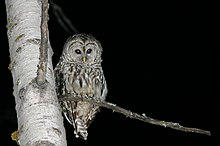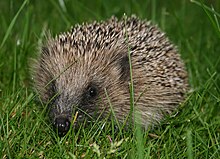Nocturnality
This article needs additional citations for verification. (May 2012) |

Nocturnality is a behavior in some non-human animals characterized by being active during the night and sleeping during the day. The common adjective is "nocturnal", versus diurnal meaning the opposite.
Nocturnal creatures generally have highly developed senses of
Origins

While it is difficult to say which came first, nocturnality or diurnality, a hypothesis in
Advantages
Resource competition

Being active at night is a form of
Predation
Nocturnality is a form of
Water conservation
Another reason for nocturnality is avoiding the heat of the day. This is especially true in
Many plant species native to arid biomes have adapted so that their flowers only open at night when the sun's intense heat cannot wither and destroy their moist, delicate blossoms. These flowers are
Climate-change and the change in global temperatures has led to an increasing amount of diurnal species to push their activity patterns closer towards crepuscular or fully nocturnal behavior. This adaptive measure allows species to avoid the heat of the day, without having to leave that particular habitat.[10]
Human disturbances
The exponential increase in human expansion and technological advances in the last few centuries has had a major effect on nocturnal animals, as well as diurnal species. The causes of these can be traced to distinct, sometimes overlapping areas: light pollution and spatial disturbance.
Light pollution

Light pollution is a major issue for nocturnal species, and the impact continues to increase as electricity reaches parts of the world that previously had no access.[11] Species in the tropics are generally more affected by this due to the change in their relatively constant light patterns, but temperate species relying on day-night triggers for behavioral patterns are also affected as well. Many diurnal species see the benefit of a "longer day", allowing for a longer hunting period which is detrimental to their nocturnal prey trying to avoid them.[8]
Orientation
Light pollution can disorient species that are used to darkness, as their adaptive eyes are not as used to the artificial lighting. Insects are the most obvious example, who are attracted by the lighting and are usually killed by either the heat or electrical current.[12] Some species of frogs are blinded by the quick changes in light, while nocturnal migratory birds may be disoriented, causing them to lose direction, tire out, or be captured by predators.[8] Sea turtles are particularly affected by this, adding to a number of threats to the different endangered species. Adults are likely to stay away from artificially lit beaches that they might prefer to lay eggs on, as there is less cover against predators.[8][12] Additionally, baby sea turtles that hatch from eggs on artificially lit beaches often get lost, heading towards the light sources as opposed to the ocean.[12]
Rhythmic behaviors
Rhythmic behaviors are affected by light pollution both seasonally and daily patterns. Migrating birds or mammals might have issues with the timing of their movement for example.[12] On a day-to-day basis, species can see significant changes in their internal temperatures, their general movement, feeding and body mass.[13] These small scale changes can eventually lead to a population decline, as well as hurting local trophic levels and interconnecting species.[13] Some typically diurnal species have even become crepuscular or nocturnal as a result of light pollution and general human disturbance.[13]
Reproduction
There have been documented effects of light pollution on reproductive cycles and factors in different species. It can affect mate choice, migration to breeding grounds, and nest site selection.[8] In male green frogs, artificial light causes a decrease in mate calls and continued to move around instead of waiting for a potential mate to arrive.[14] This hurts the overall fitness of the species, which is concerning considering the overall decrease in amphibian populations.[14]
Predation
Some nocturnal predator-prey relationships are interrupted by artificial lighting. Bats that are fast-moving are often at an advantage with insects being drawn to light; they are fast enough to escape any predators also attracted to the light, leaving slow-moving bats at a disadvantage.[8] Another example is harbor seals eating juvenile salmon that moved down a river lit by nearby artificial lighting. Once the lights were turned off, predation levels decreased.[8] Many diurnal prey species forced into being nocturnal are susceptible to nocturnal predators and those species with poor nocturnal eyesight often bear the brunt of the cost.[13]
Spatial disturbance
The increasing amount of habitat destruction worldwide as a result of human expansion has given both advantages and disadvantages to different nocturnal animals. As a result of peak human activity in the daytime, more species are likely to be active at night in order to avoid the new disturbance in their habitat.[15] Carnivorous predators however are less timid of the disturbance, feeding on human waste and keeping a relatively similar spatial habitat as they did before.[15] In comparison, herbivorous prey tend to stay in areas where human disturbance is low, limiting both resources and their spatial habitat. This leads to an imbalance in favor of predators, who increase in population and come out more often at night.[15]
In captivity
Zoos
In
Pets

See also
- Adaptation
- Antipredator adaptation
- Competitive exclusion principle
- Crepuscular
- Crypsis
- Diurnality
- List of nocturnal animals
- List of nocturnal birds
- Niche (ecology)
- Niche differentiation
- Night owl (person)
- Tapetum lucidum
References
- .
- ^ PMID 23097513.
- PMID 23825205.
- ^ PMID 30381378.
- ^ "Are All Owls Nocturnal? All the Best FACTS Here!". Birds At First Sight. 2023-08-19. Retrieved 2023-09-14.
- PMID 32478390. Retrieved 2021-08-28.
- PMID 34293132.
- ^ S2CID 33259398.
- ISBN 0-8053-1957-3
- ISSN 0012-9615.
- PMID 23335816.
- ^ a b c d Witherington, B.E. (1997). "The problem of photopollution for sea turtles and other nocturnal animals". In Clemmons, J.R.; Buchholz, R. (eds.). Behavioral Approaches to Conservation in the Wild. Cambridge: Cambridge University Press. pp. 303–328.
- ^ S2CID 49212187.
- ^ ISSN 0008-4301.
- ^ PMID 29379083.
- ^ Debra Horwitz; Gary Landsberg. "Nocturnal Activity in Cats". VCA Antech. Archived from the original on 1 May 2013. Retrieved 7 October 2012.

